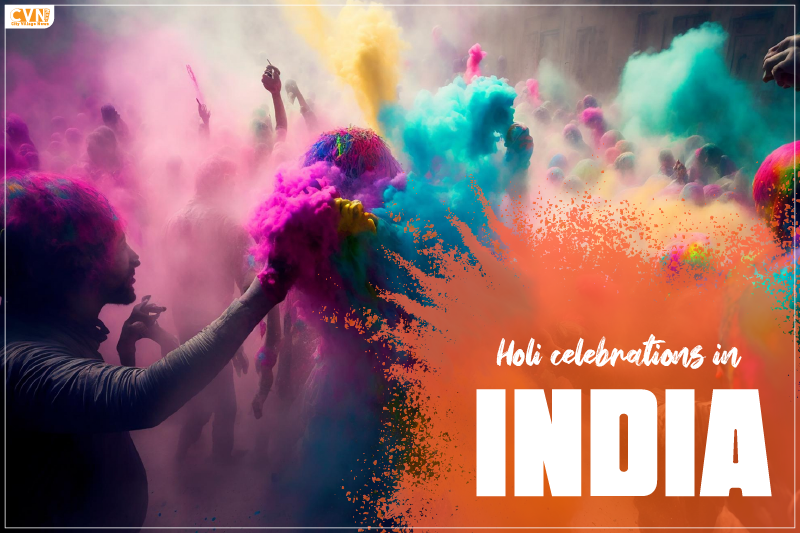The sky is filled with colors, kids are running with pichkaris, old uncles are sitting and enjoying gujiyas, and people are smudging faces with gulaal. You might be thinking what this description is all about. The answer is ‘Holi Celebration’. This is how people celebrate Holi in India. But did you know that there are different types of Holi celebrations in India depending on the state? Yes, in every state, people celebrate Holi, the festival of colors differently. Let’s have a look at the uniqueness of celebrating this festival in different states and regions.
Unique Ways of Celebrating Holi in India
Lathmar Holi, Barsana Village
Lathmar Holi is one of the most unique and popular types of Holi celebrations. As per the tradition, women come armed with sticks & hit men playfully and men defend themselves with shields. It might look dangerous. However, this is the beauty of this festival. Lathmar Holi is fun to watch and entertaining to play.
Phoolon ki Holi, Vrindavan, and Pushkar
As the name suggests, ‘Holi of Flowers’ is played by throwing flowers at each other. The temples of Pushkar and Vrindavan are filled with flowers. People use organic colors made up of Kesudo and Palash flowers to play Holi here. It’s a different experience of being in Vrindavan during Holi, getting covered with flower petals & vibrant colors.
Hola Mohalla, Punjab
Hola Mohalla, also known as ‘Holi for Warriors’, is celebrated in Punjab. The festival exhibits a display of martial arts, horse riding, and exhibitions followed by music and poetry competitions.
Royal Holi, Rajasthan
It is a grand-level Holi celebration organized by Udaipur’s Mewar royal family. Locals light bonfires called ‘Holika Dahan’ followed by a royal parade with decorated horses, camels, elephants, etc.
Rang Panchami, Maharashtra
Rang Panchami, also known as Shimga, starts with the ritual of lighting a pyre of firewood known as Holika Dahan. People celebrate this festival with colors and water on the fifth day after Dahan.
Phaguwa, Bihar
In the local Bhojpuri dialect, Holi is called Phaguwa. The first day is celebrated as Holika Dahan followed by the Holi celebration with dry & wet colors and water. Holi in Bihar is incomplete without dance, music, gujiya, dahi bhalle, and the famous thandai. So, if you want to see the real festivities, see Bihar’s Holi.
Shigmo, Goa
Shigmo is the spring festival in Goa. It is divided into two categories, Dhakto Shigmo (small Shigmo) and Vhadlo Shigmo (big Shigmo). The small Shigmo is celebrated by farmers, and laborers and the big Shigmo is celebrated by everyone else. During this festival, fishermen decorate their boats and organize a massive carnival with traditional folk songs and street dance.
Basant Utsav, West Bengal
This festival is celebrated to welcome Basant Ritu (Spring Season). On this day, people dress up in yellow color, play Holi with gulaal, and sing & dance. The hotspot of this festival is Shanti Niketan where you can experience the joy and beauty inculcated in the Bengali traditions.
Dola Utsav, Odisha
Dola, a five-to-seven-day-long festival, is celebrated in the northern state of Odisha. During this Utsav, all the rituals are performed to worship Lord Krishna and Radha. The devotees take out yatra (religious gathering) of Lord Jagannath, offer flowers, Bhog (sweets), put Abira (powdered color), and play Holi.
Manjal Kuli, Kerala
Holi is not as popular in South India as compared to North India. However, God’s Own Country, Kerala has its unique version of the Holi celebration. Manjal Kuli, also known as Ukuli, is celebrated by Kumba and Konkani, two communities of Kerala. They traditionally celebrate Holi by gathering at temples, dancing, singing, and splashing color or turmeric water.
These are some of the types of Holi celebrations in India. Though the ways are different in different states of Holi celebrations, the spirit and enthusiasm remain the same. You can visit any place in India to witness this festival of colors and will feel the same vibe. So, what are you waiting for? Fly to India and see the flavors of Holi, different cultures, festivities, and traditions.
FAQs
How many types of Holi are celebrated in India?
Holi celebration in India varies from state to state and region to region. Here are some ways of celebrating Holi listed below:
- Lathmar Holi, Barsana Village
- Phoolon ki Holi, Vrindavan, and Pushkar
- Hola Mohalla, Punjab
- Royal Holi, Rajasthan
- Rang Panchami, Maharashtra
- Phaguwa, Bihar
- Shigmo, Goa
- Basant Utsav, West Bengal
- Dola Utsav, Odisha
- Manjal Kuli, Kerala
How is Holi celebrated?
The three activities to celebrate Holi are:
- Collect and stack the wood, and light the bonfire. This is called Holika Dahan.
- The next day, play Holi with colors and water.
- After that, cook delicious food, make sweets, and eat with your family.

